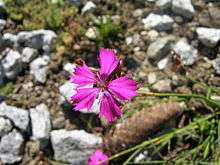Dianthus carthusianorum
Dianthus carthusianorum, commonly known as Carthusian pink, is a species of Dianthus, native to Europe, from Spain north to Belgium and Poland, and east to Ukraine, occurring in dry, grassy habitats at elevations of up to 2,500 meters (8,200 ft) in mountains.[1][2]
| Dianthus carthusianorum | |
|---|---|
 | |
| Scientific classification | |
| Kingdom: | Plantae |
| Clade: | Tracheophytes |
| Clade: | Angiosperms |
| Clade: | Eudicots |
| Order: | Caryophyllales |
| Family: | Caryophyllaceae |
| Genus: | Dianthus |
| Species: | D. carthusianorum |
| Binomial name | |
| Dianthus carthusianorum | |
It is a variable herbaceous perennial plant growing to 60 centimeters (24 in) tall. The leaves are slender, up to 7 centimeters (2.8 in) long and 5 millimeters (0.20 in) broad. The flowers are 18–20 millimeters (0.71–0.79 in) wide, dark pink to purple, occasionally white; they are produced several together in tight flowerhead.[2][3]
Gallery
 subsp. carthusianorum
subsp. carthusianorum subsp. alpestris
subsp. alpestris
gollark: Wait, just ask the NSA, they'll have it.
gollark: But *now* information is more widely replicated, isn't it?
gollark: But there are loads of random search engine caches and stuff which might store your datas.
gollark: I mean, archive.org stores basically anything of significant interest, but it does respond to copyright and stuff.
gollark: The question is, though, how easily can such a feat be replicated nowadays?
References
- Flora Europaea: Dianthus carthusianorum
- Blamey, M. & Grey-Wilson, C. (1989). Flora of Britain and Northern Europe. ISBN 0-340-40170-2
- Huxley, A., ed. (1992). New RHS Dictionary of Gardening. Macmillan ISBN 0-333-47494-5.
This article is issued from Wikipedia. The text is licensed under Creative Commons - Attribution - Sharealike. Additional terms may apply for the media files.